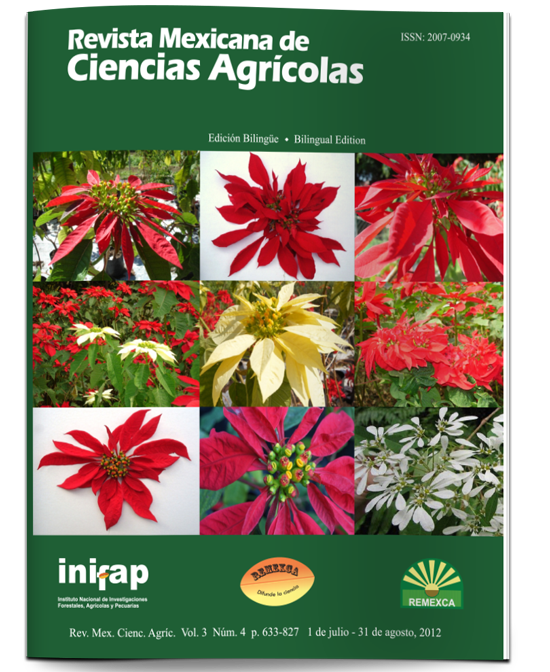Climate variability and agricultural productivity in areas with erratic rainfall patterns
DOI:
https://doi.org/10.29312/remexca.v3i4.1433Keywords:
climate uncertainty, modeling, riskAbstract
The high variability in space and time of the rainfall patterns, make agriculture in rainfed areas subject to climatic risk. In this situation, the best tool to support decision-making is the hydro-climatic modeling, where the hydrological stochastic processes are considered. In the present study, nested series of algorithms (AA) are used in order to estimate maize crop yield under different climate scenarios. The algorithm is calibrated and applied to a poor rainfed region in northern Mexico (Cuencamé, Durango). It is part of a weather generator (WXPARM) for climate parameters that define the region later to quantify the impact of maize yield under climatic change conditions; using a rescaled model to apply global climatic data models (GCMs) at plot level (SDM) and finally the matrices that define the monthly weather conditions in the region of study are used in a model to assess the impact on yield (EPIC) by modeling the balance of moisture in the soil. The results indicate that under climatic change scenarios, it is expected a yield increases of up to 0.3 t ha-1 as the change in expected weather patterns, expecting a bimodal behavior. According to the weather patterns in the future, it might be considered to adjusting planting dates for the maximum crop requirements coinciding with the presence of rain.
Downloads
Downloads
Published
How to Cite
Issue
Section
License
The authors who publish in Revista Mexicana de Ciencias Agrícolas accept the following conditions:
In accordance with copyright laws, Revista Mexicana de Ciencias Agrícolas recognizes and respects the authors’ moral right and ownership of property rights which will be transferred to the journal for dissemination in open access. Invariably, all the authors have to sign a letter of transfer of property rights and of originality of the article to Instituto Nacional de Investigaciones Forestales, Agrícolas y Pecuarias (INIFAP) [National Institute of Forestry, Agricultural and Livestock Research]. The author(s) must pay a fee for the reception of articles before proceeding to editorial review.
All the texts published by Revista Mexicana de Ciencias Agrícolas —with no exception— are distributed under a Creative Commons License Attribution-NonCommercial 4.0 International (CC BY-NC 4.0), which allows third parties to use the publication as long as the work’s authorship and its first publication in this journal are mentioned.
The author(s) can enter into independent and additional contractual agreements for the nonexclusive distribution of the version of the article published in Revista Mexicana de Ciencias Agrícolas (for example include it into an institutional repository or publish it in a book) as long as it is clearly and explicitly indicated that the work was published for the first time in Revista Mexicana de Ciencias Agrícolas.
For all the above, the authors shall send the Letter-transfer of Property Rights for the first publication duly filled in and signed by the author(s). This form must be sent as a PDF file to: revista_atm@yahoo.com.mx; cienciasagricola@inifap.gob.mx; remexca2017@gmail.
This work is licensed under a Creative Commons Attribution-Noncommercial 4.0 International license.



